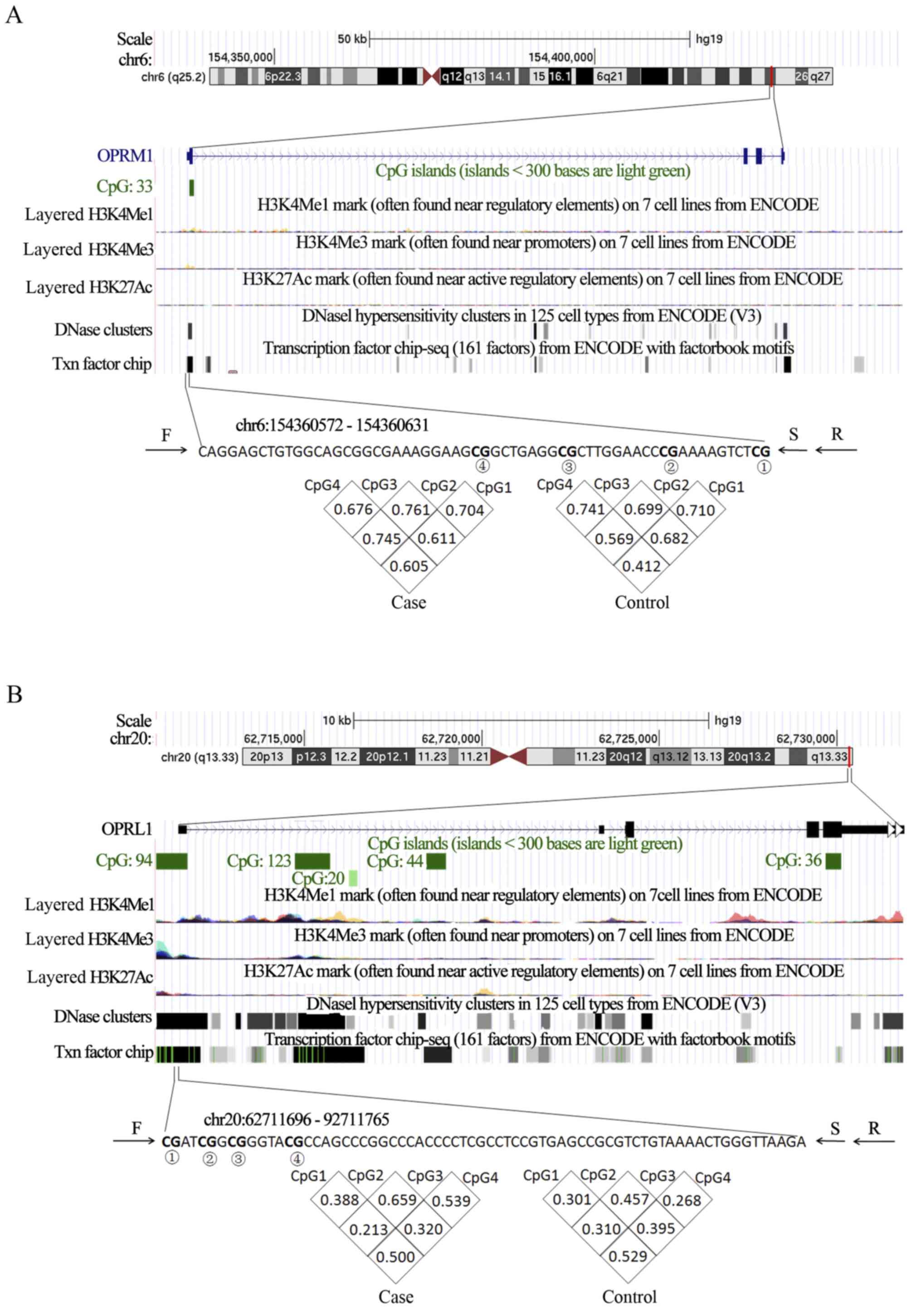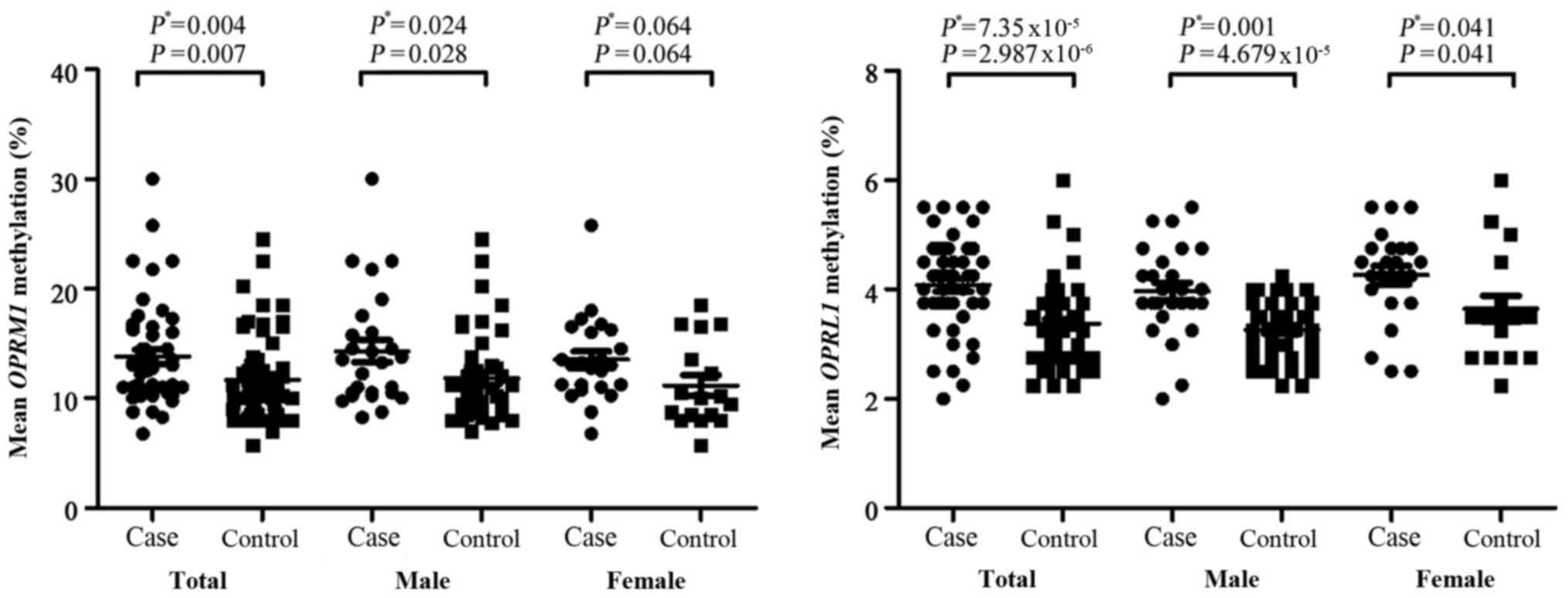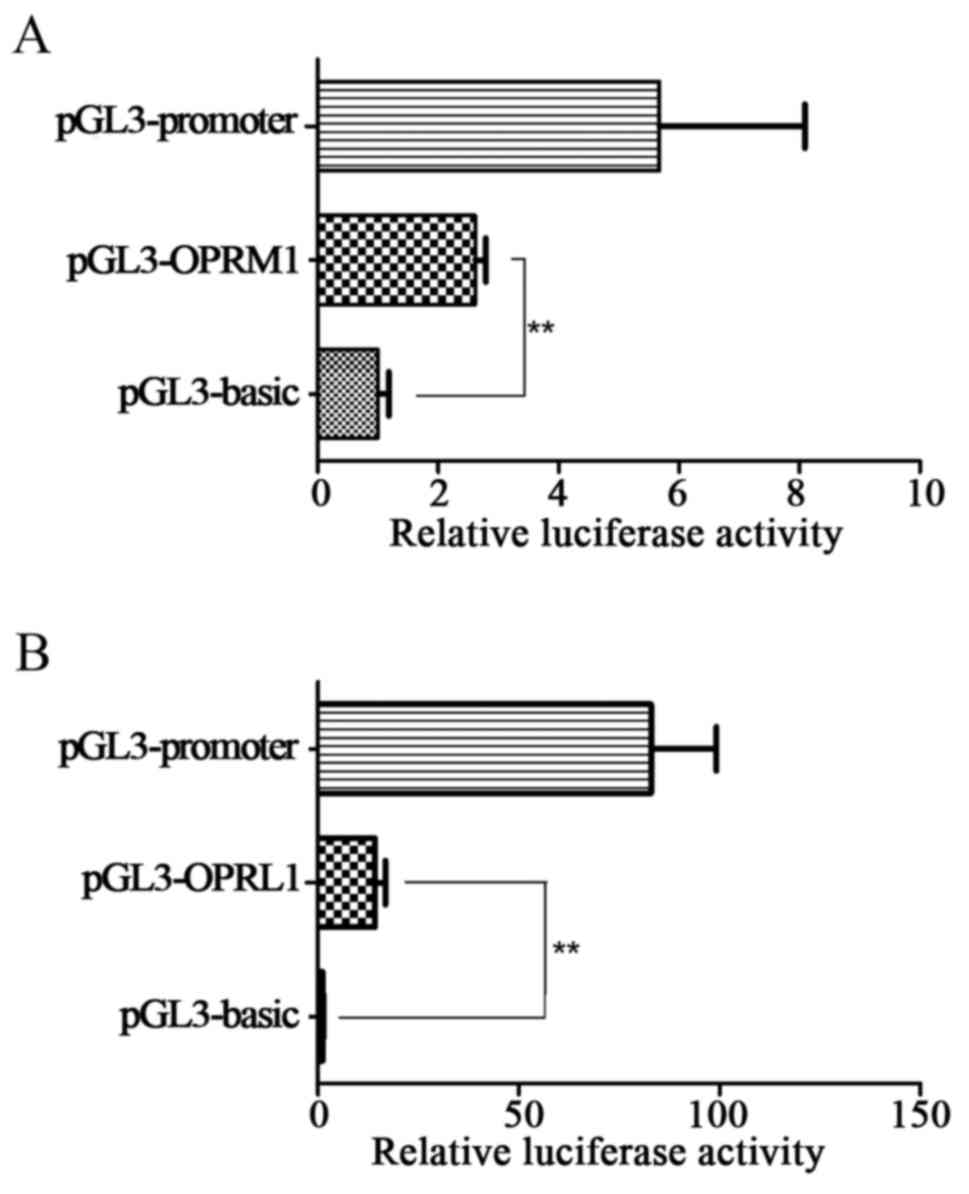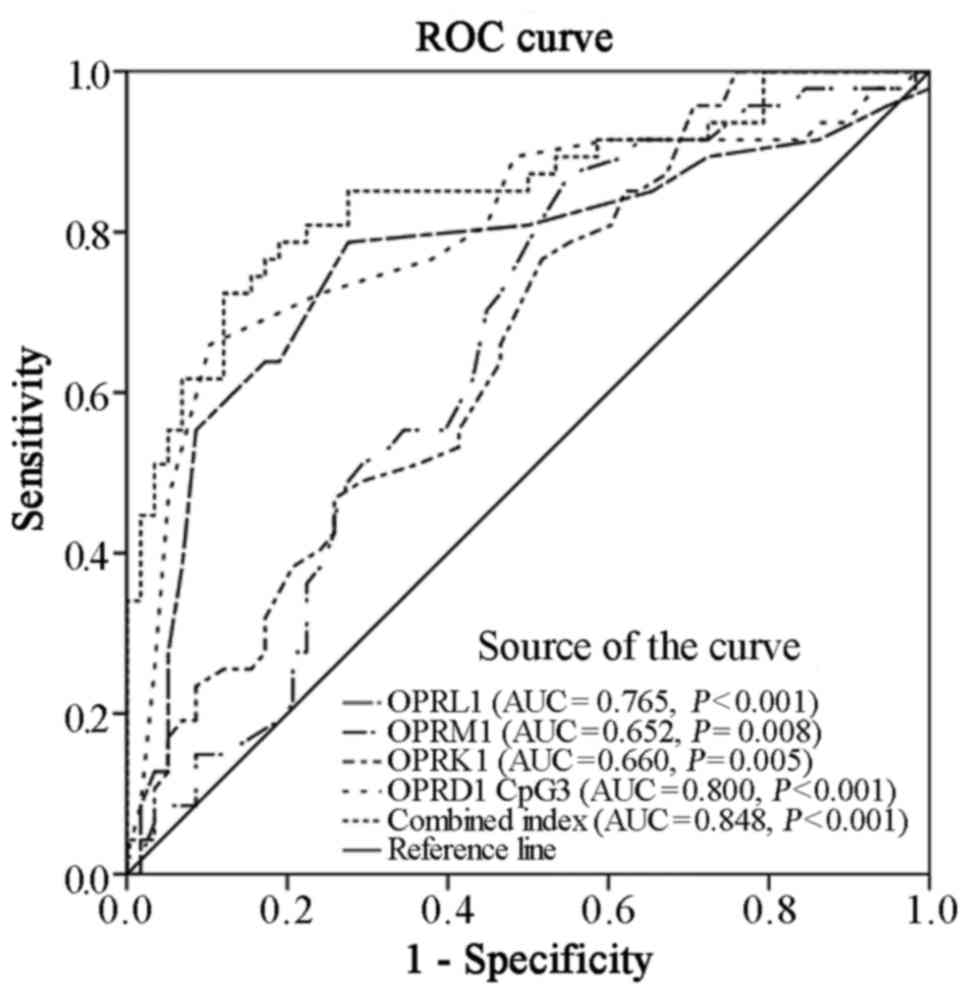Elevated methylation of OPRM1 and OPRL1 genes in Alzheimer's disease
- Authors:
- Published online on: August 24, 2018 https://doi.org/10.3892/mmr.2018.9424
- Pages: 4297-4302
-
Copyright: © Xu et al. This is an open access article distributed under the terms of Creative Commons Attribution License.
Abstract
Introduction
Alzheimer's disease [AD, (MIM:104300)] is a complex neurodegenerative disorder, affecting approximately 5% of the population worldwide. The prevalence of AD increases markedly after the age of 65 (1), and it accounts for 65–75% of total dementia cases (2). The development of AD is a complex process involving genetic (3,4), physiological, and environmental factors. AD is thought to result from the deposition of β-amyloid (Aβ) peptides and intraneuronal neurofibrillary tangles (NFTs) in the brain (5,6). The alterations in DNA methylation that result from both genetic and environmental causes, have become an emerging topic of interest in AD research (7–9).
The opioid receptor family includes three major opioid receptors (κ-, δ- and µ-opioid receptors), and nociceptin, an opioid receptor-like 1 (OPRL1) receptor. The previous study conducted by our group demonstrated that increased methylation in OPRK1 (κ-opioid receptor gene) and OPRD1 (δ-opioid receptor gene) was associated with AD (9). Furthermore, the mu-opioid receptor, encoded by opioid receptor µ1 (OPRM1), is a major molecular target of morphine and the primary target for its neuropharmacological effects (10). OPRM1 was also found to be linked with morphine-induced immunosuppression (11). It is interesting to note that the mu-opioid receptor was shown to attenuate Aβ oligomer-induced neurotoxicity by a recent study (12). The opioid related nociceptin receptor 1 (OPRL1) is widely expressed in the central nervous system, including the hippocampal dentate gyrus, cortical areas, striatum, thalamus, and hypothalamus (13–15). OPRL1 has been found to play an essential role in cognition (16), and to modulate inflammation and immune responses (17). In light of these findings, the present study investigated the association of OPRM1 and OPRL1 methylation with AD.
Materials and methods
Sample collection
A total of 51 sporadic AD patients and 63 normal subjects were recruited from Ningbo No. 1 Hospital and Ningbo Kangning Hospital, based on the ICD-10 diagnostic criteria (18). All participants were Han Chinese, and were living in Ningbo city of the Zhejiang province. Their detailed information was collected as described previously (7). The present study was approved by the Ethics Committees of Ningbo No. 1 Hospital and Ningbo Kangning Hospital, and all participants signed the informed consent for their participation in the study. Each patient was independently diagnosed by two experienced neurologists. The details of patient screening and diagnosis, and the preparation of samples were performed as described previously (7,9). The concentration of blood metabolites, including triglycerides (TG), total cholesterol (TC), homocysteine (Hcy), blood glucose (Glu), high density lipoprotein (HDL), lipoprotein A (Lp(a)), and alkaline phosphatase (ALP), were measured from each participant. The biochemical parameters of the blood samples were detected using previously described methods (7,19). Bisulfite pyrosequencing assay.
DNA extraction from peripheral blood and subsequent bisulfite conversion were performed as previously described (7,9). DNA methylation was measured by pyrosequencing technology (Pyromark Gold Q24 Reagents; Qiagen, Dulce, Germany). The primer sequences were as follows: 5′-biotin-TAGTTAGGATTGGTTTTTGTAAGAAATAG-3′ for the OPRM1 forward primer, 5′-ATACCCCAAAACATCAATACAATTACTAAC-3′ for the OPRM1 reverse primer, 5′-CTATACCAAATAACCAAAAACAC-3′ for the OPRM1 sequencing primer, 5′-biotin-GTTTGTTTAGTTTGGGAAAGAGG-3′ for the OPRD1 forward primer, 5′-ACACAAAAATCTCCCCCTTC-3′ for the OPRD1 reverse primer, and 5′-ACCCCCCACAACACA-3′ for the OPRD1 sequencing primer.
Dual-luciferase assays
OPRM1 and OPRL1 fragments (OPRM1: From +123 to +677 bp; OPRL1: From +110 to +500 bp) were synthesized and cloned into the pGL3-basic vector (Sirui Biotech, Ningbo, China). HEK-293T cell culture and seeding were conducted as previously described (9,20). Transient transfections with pRL-SV40 vectors for transfection efficiency control of both constructs were conducted according to TransLipid® HL Transfection Reagent manufacturer protocols (TransGen Biotech, Beijing, China). Following 18 to 72 h of transfection, the activities of Renilla and firefly luciferase were measured using the Dual-Luciferase® Reporter Assay Systems (Promega, Madison, WI, USA). The luminescence was quantified with a SpectraMax 190 (Sunnyvale, CA, USA). The pGL3 Promoter Vector (Promega Corporation, Madison, WI, USA), which comprised an SV40 promoter upstream of the luciferase gene, was used as positive control. Three independent transfections were conducted for each construct in triplicate.
Statistical analyses
SPSS software version 16.0 (SPSS, Inc, Chicago, IL, USA) was used for all statistical calculations. The two tailed independent samples t-test and one-way analysis of variance followed by a Bonferroni post hoc test were used to assess differences between continuous variables. Receiver operating characteristic (ROC) analysis was employed to evaluate the diagnostic value of gene methylation for AD. P<0.05 was considered to indicate a statistically significant difference.
Results
As shown in Fig. 1, significant pairwise correlations between CpG sites of both genes were identified (P<0.001). Therefore, the mean methylation of each gene was used in the subsequent analyses. To evaluate the potential role of OPRM1 and OPRL1 methylation in the risk of AD, we carefully selected AD patient and control groups. No significant differences in biological and/or physiological characteristics were noted between the two groups, with the exception of the parameter smoking status (P=0.025; Table I) (21). The case-control comparisons revealed significantly higher methylation levels of OPRM1 and OPRL1 in AD patients compared with healthy controls (smoking-adjusted P<0.05, Table I and Fig. 2). Subgroup analyses by gender indicated that the methylation levels of OPRM1 and OPRL1 were significantly and/or moderately increased in AD patients compared with control subjects, in both male and female participants (Table I and Fig. 2). In addition, no significant correlation between OPRM1 and OPRL1 methylation was noted (P>0.05, data not shown).
Table I.Comparison of the mean methylation levels of OPRM1 and OPRL1 between AD cases and control subjects. |
Functional activities of the target regions of OPRM1 and OPRL1 were assessed with dual-luciferase reporter gene assays. Both gene promoter fragments were able to significantly increase luciferase expression levels (Fig. 3, OPRM1: Fold-change=2.616, P=0.003, OPRL1: Fold-change=11.395, P=0.007).
Taken together, the data indicated that the four opioid receptor genes (OPRK1, OPRM1, OPRD1 and OPRL1) had higher methylation levels in AD patients compared with healthy subjects. These conclusions were consistent with our previous studies. ROC analyses were conducted for each gene and their combined index was used to evaluate their diagnostic values for AD. As expected, the combined index of methylation of all four genes was more informative than that of each single gene (combined index: AUC=0.843, OPRL1: AUC=0.765, OPRM1: AUC=0.652, OPRK1: AUC=0.660, OPRD1: AUC=0.800, Fig. 4).
Discussion
The present study provides substantial evidence the methylation levels of OPRM1 and OPRL1 are associated with AD. Using a dual-luciferase assay, we demonstrated that the promoter fragments with the tested CG sites could enhance gene transcription, and that their hypermethylation could influence their expression levels. Moreover, ROC analyses indicated a significant contribution of opioid receptor gene methylation to the prediction of AD risk.
Opioid receptors with their ligands comprise an important signaling pathway in the central nervous system (20,22,23). Considerable evidence supports their involvements in tau hyperphosphorylation, Aβ production, and neuro-inflammation (24), suggesting a connection with AD pathogenesis. Promoter DNA methylation is well-known for its function in gene expression, and aberrant regulation of opioid receptors may play a role in disease pathologies, as shown by previous studies conducted on methylation of opioid receptor genes (25). For example, hypermethylated OPRM1 was shown to inhibit the analgesic effect of morphine in a mouse model of neuropathic pain, while its demethylation restored morphine function (26). Similarly, OPRM1 was hypermethylated in oral cancer, and demethylation of OPRM1 provided an analgesic effect similar to that noted by demethylating drugs (27). Furthermore, opiate addicts indicated higher OPRM1 methylation levels compared with control subjects (28). Previous results have further revealed increased methylation levels for OPRL1 in patients with alcohol dependence as well as in control subjects who experienced childhood adversity (29). In the present study, hypermethylation of both OPRM1 and OPRL1 genes was shown to be associated with AD. The results suggest that a low density of opioid receptors is noted in AD. Moreover, previous evidence indicated altered densities of opioid receptors in various AD brain regions (24,30). However, the precise mechanism involved in these alterations and its association with methylation requires further research. It is important to note that the, present data suggest a possible diagnostic application for AD by a combinatorial approach. Opioid receptors have shown potential as therapeutic targets in neuropsychiatric diseases as demonstrated by previous studies (31,32). Given the wide distribution of opioid receptor expression in the brain, and the absence of previous blood-based studies on the association between opioid receptor genes methylation and AD, further work is necessary to confirm our findings and test the present hypothesis.
A few limitations are evident in the present study. Firstly, the sample size was small, and additional, larger studies will be necessary to confirm these findings. Secondly, the OPRM1 and OPRL1 DNA fragments analyzed may not fully represent the overall level of DNA methylation in both genes, and thus their total contribution to AD may not be accurately represented. In addition, since AD is a neurological disease, future studies using brain tissue are required to confirm our results.
In summary, the present findings on OPRM1 and OPRL1 methylation together with our previous study on OPRK1 and OPRD1, suggest an epigenetic involvement of the opioid system in AD, and a potential diagnostic value of opioid receptor methylation for AD.
Acknowledgements
The authors would like to thank Ningbo No. 1 Hospital and Ningbo Kangning Hospital (Ningbo, China) for providing the samples.
Funding
The present study was supported by grants from the National Natural Science Foundation of China (grant nos. U1503223, 81271209, 81070873 and 81371469), the Applied Research Project on Nonprofit Technology of Zhejiang Province (grant no. 2015C33155), the Natural Science Foundation of Zhejiang Province (grant nos. LY15H090010, LR13H020003 and Y15H090032), the Ningbo Natural Science Fund (grant no. 2014A610257), the Disciplinary Project of Ningbo University (grant no. B01350104900), the K. C. Wong Magna Fund in Ningbo University, Public Technology Research and Social Development Project of Zhejiang Province (grant no. 2015C33155), and the Excellent Paper Cultivated Fund of Ningbo University (grant no. 014-F01660148000).
Availability of data and materials
The datasets used and/or analyzed during the current study are available from the corresponding author on reasonable request.
Authors' contributions
CX, GL and HJ performed the majority of the experiments, data collection, statistical analysis, data interpretation and wrote the manuscript. WHC, DD, ZC, DZ and LX performed sample collection, the biochemical tests and collated the data. HH, WC, LC, QZ and LL analyzed the data and revised the manuscript. SD and QW revised the manuscript critically for important intellectual content, designed the overall study, supervised the experiments, analyzed the results and wrote the paper.
Ethics approval and consent to participate
The present study was approved by the Ethics Committees of Ningbo No. 1 Hospital and Ningbo Kangning Hospital (Zhejiang, China), and all participants provided written informed consent for their participation in the study.
Patient consent for publication
Not applicable.
Competing interests
The authors declare that they have no competing interests.
References
|
Ghebranious N, Mukesh B, Giampietro PF, Glurich I, Mickel SF, Waring SC and McCarty CA: A pilot study of gene/gene and gene/environment interactions in Alzheimer disease. Clin Med Res. 9:17–25. 2011. View Article : Google Scholar : PubMed/NCBI | |
|
Adlard PA, Tran BA, Finkelstein DI, Desmond PM, Johnston LA, Bush AI and Egan GF: A review of β-amyloid neuroimaging in Alzheimer's disease. Front Neurosci. 8:3272014. View Article : Google Scholar : PubMed/NCBI | |
|
Piaceri I, Nacmias B and Sorbi S: Genetics of familial and sporadic Alzheimer's disease. Front Biosci (Elite Ed). 5:167–177. 2013. View Article : Google Scholar : PubMed/NCBI | |
|
Alonso Vilatela ME, Lopez-Lopez M and Yescas-Gomez P: Genetics of Alzheimer's disease. Arch Med Res. 43:622–631. 2012. View Article : Google Scholar : PubMed/NCBI | |
|
Rao AT, Degnan AJ and Levy LM: Genetics of Alzheimer disease. AJNR Am J Neuroradiol. 35:457–458. 2014. View Article : Google Scholar : PubMed/NCBI | |
|
Armstrong RA: What causes Alzheimer's disease? Folia Neuropathol. 51:169–188. 2013. View Article : Google Scholar : PubMed/NCBI | |
|
Chang L, Wang Y, Ji H, Dai D, Xu X, Jiang D, Hong Q, Ye H, Zhang X, Zhou X, et al: Elevation of peripheral BDNF promoter methylation links to the risk of Alzheimer's disease. PLoS One. 9:e1107732014. View Article : Google Scholar : PubMed/NCBI | |
|
Deng Y and Yu G: The effect of DNA methylation on β-amyloid accumulation in Alzheimer's disease. Yi Chuan. 36:295–300. 2014.(In Chinese). PubMed/NCBI | |
|
Ji H, Wang Y, Liu G, Xu X, Dai D, Chen Z, Zhou D, Zhou X, Han L, Li Y, et al: OPRK1 promoter hypermethylation increases the risk of Alzheimer's disease. Neurosci Lett. 606:24–29. 2015. View Article : Google Scholar : PubMed/NCBI | |
|
Matthes HW, Maldonado R, Simonin F, Valverde O, Slowe S, Kitchen I, Befort K, Dierich A, Le Meur M, Dollé P, et al: Loss of morphine-induced analgesia, reward effect and withdrawal symptoms in mice lacking the mu-opioid-receptor gene. Nature. 383:819–823. 1996. View Article : Google Scholar : PubMed/NCBI | |
|
Gaveriaux-Ruff C, Matthes HW, Peluso J and Kieffer BL: Abolition of morphine-immunosuppression in mice lacking the mu-opioid receptor gene. Proc Natl Acad Sci USA. 95:6326–6330. 1998. View Article : Google Scholar : PubMed/NCBI | |
|
Wang Y, Wang YX, Liu T, Law PY, Loh HH, Qiu Y and Chen HZ: µ-Opioid receptor attenuates Aβ oligomers-induced neurotoxicity through mTOR signaling. CNS Neurosci Ther. 21:8–14. 2015. View Article : Google Scholar : PubMed/NCBI | |
|
Levran O, Yuferov V and Kreek MJ: The genetics of the opioid system and specific drug addictions. Hum Genet. 131:823–842. 2012. View Article : Google Scholar : PubMed/NCBI | |
|
Kuzmin A, Bazov I, Sheedy D, Garrick T, Harper C and Bakalkin G: Expression of pronociceptin and its receptor is downregulated in the brain of human alcoholics. Brain Res. 1305 Suppl:S80–S85. 2009. View Article : Google Scholar : PubMed/NCBI | |
|
Peluso J, LaForge KS, Matthes HW, Kreek MJ, Kieffer BL and Gaveriaux-Ruff C: Distribution of nociceptin/orphanin FQ receptor transcript in human central nervous system and immune cells. J Neuroimmunol. 81:1–192. 1998. View Article : Google Scholar : PubMed/NCBI | |
|
Zaveri N: Peptide and nonpeptide ligands for the nociceptin/orphanin FQ receptor ORL1: Research tools and potential therapeutic agents. Life Sci. 73:663–678. 2003. View Article : Google Scholar : PubMed/NCBI | |
|
Kruger C, Köthe L, Struppert A, Pietruck C, Simm A and Grond S: Expression und function of the ORL-1 receptor on human leukocytes. Schmerz. 20:509–518. 2006. View Article : Google Scholar : PubMed/NCBI | |
|
International Advisory Group for the Revision of ICD-10 Mental and Behavioural Disorders, . A conceptual framework for the revision of the ICD-10 classification of mental and behavioural disorders. World Psychiatry. 10:86–92. 2011. View Article : Google Scholar : PubMed/NCBI | |
|
Jiang D, Zheng D, Wang L, Huang Y, Liu H, Xu L, Liao Q, Liu P, Shi X, Wang Z, et al: Elevated PLA2G7 gene promoter methylation as a gender-specific marker of aging increases the risk of coronary heart disease in females. PLoS One. 8:e597522013. View Article : Google Scholar : PubMed/NCBI | |
|
Xu X, Ji H, Liu G, Wang Q, Liu H, Shen W, Li L, Xie X, Zhou W and Duan S: A significant association between BDNF promoter methylation and the risk of drug addiction. Gene. 584:54–59. 2016. View Article : Google Scholar : PubMed/NCBI | |
|
Ji H, Wang Y, Liu G, Chang L, Chen Z, Zhou D, Xu X, Cui W, Hong Q, Jiang L, et al: Elevated OPRD1 promoter methylation in Alzheimer's disease patients. PLoS One. 12:e01723352017. View Article : Google Scholar : PubMed/NCBI | |
|
Conason AH and Sher L: Alcohol use in adolescents with eating disorders. Int J Adolesc Med Health. 18:31–36. 2006. View Article : Google Scholar : PubMed/NCBI | |
|
Snyder SH and Childers SR: Opiate receptors and opioid peptides. Annu Rev Neurosci. 2:35–64. 1979. View Article : Google Scholar : PubMed/NCBI | |
|
Cai Z and Ratka A: Opioid system and Alzheimer's disease. Neuromolecular Med. 14:91–111. 2012. View Article : Google Scholar : PubMed/NCBI | |
|
Sun Y, Sahbaie P, Liang D, Li W, Shi X, Kingery P and Clark JD: DNA methylation modulates nociceptive sensitization after incision. PLoS One. 10:e01420462015. View Article : Google Scholar : PubMed/NCBI | |
|
Zhou XL, Yu LN, Wang Y, Tang LH, Peng YN, Cao JL and Yan M: Increased methylation of the MOR gene proximal promoter in primary sensory neurons plays a crucial role in the decreased analgesic effect of opioids in neuropathic pain. Mol Pain. 10:512014. View Article : Google Scholar : PubMed/NCBI | |
|
Viet CT, Dang D, Ye Y, Ono K, Campbell RR and Schmidt BL: Demethylating drugs as novel analgesics for cancer pain. Clin Cancer Res. 20:4882–4893. 2014. View Article : Google Scholar : PubMed/NCBI | |
|
Doehring A, Oertel BG, Sittl R and Lotsch J: Chronic opioid use is associated with increased DNA methylation correlating with increased clinical pain. Pain. 154:15–23. 2013. View Article : Google Scholar : PubMed/NCBI | |
|
Zhang H, Wang F, Kranzler HR, Zhao H and Gelernter J: Profiling of childhood adversity-associated DNA methylation changes in alcoholic patients and healthy controls. PLoS One. 8:e656482013. View Article : Google Scholar : PubMed/NCBI | |
|
Barg J, Belcheva M, Rowinski J, Ho A, Burke WJ, Chung HD, Schmidt CA and Coscia CJ: Opioid receptor density changes in Alzheimer amygdala and putamen. Brain Res. 632:209–215. 1993. View Article : Google Scholar : PubMed/NCBI | |
|
Butelman ER and Kreek MJ: Salvinorin A, a kappa-opioid receptor agonist hallucinogen: Pharmacology and potential template for novel pharmacotherapeutic agents in neuropsychiatric disorders. Front Pharmacol. 6:1902015. View Article : Google Scholar : PubMed/NCBI | |
|
Cunningham CW, Rothman RB and Prisinzano TE: Neuropharmacology of the naturally occurring kappa-opioid hallucinogen salvinorin A. Pharmacol Rev. 63:316–347. 2011. View Article : Google Scholar : PubMed/NCBI |













